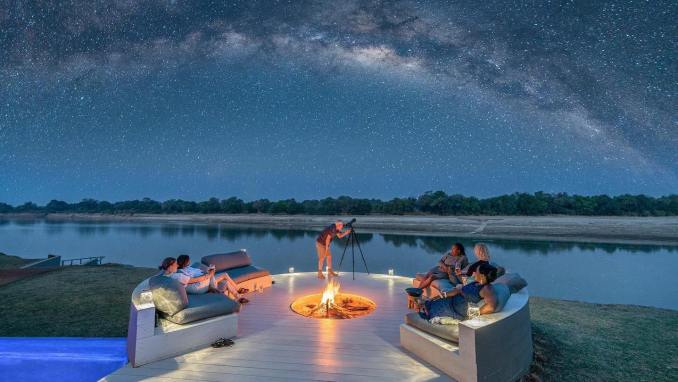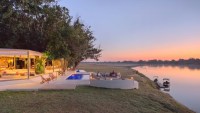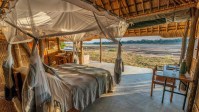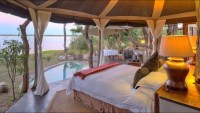The rewards of traveling in Zambia are those of exploring some of Southern Africa’s wildest and most remote wilderness areas, home to an astonishing diversity of wildlife. A Zambia safari holiday combines excellent big game viewing with luxurious unfenced lodges and some of the best guides in Africa. And although the spectacular beauty of Zambia’s immense nature reserves has long made them a favorite for safari connoisseurs, they don’t attract the crowds that cluster around sightings in the better-known parks in Africa – in fact the only bustle you’re likely to find is at the country’s most popular attraction: the world-famous Victoria Falls.
Get the most out of your (luxury) trip to Zambia with my travel guide. Find out more about:
- Best time to visit
- How to get there
- Travel requirements
- Getting around
- Inspiration, highlights, & travel tips
- Suggested itineraries
- Recommended luxury hotels (+ reviews)

BEST TIME TO VISIT
Zambia has a sub-tropical climate and its weather is defined by a marked wet and dry season rather than summer and winter.
- The dry season runs from May to October and this is the best time in Zambia to spot animals because there’s less vegetation and they gather around waterholes and rivers. Days are sunny, there’s hardly any rain, and temperatures are pleasantly mild, although September and October get extremely hot. It’s important to keep in mind that morning game drives in winter are really cold, so bring warm clothing during June, July and August.
- The rainy season (December to April) is commonly called the “Green Season” as the bush is beautifully thick and green. This however makes game viewing less easy as the vegetation is so dense plus many animals move away from dry season water sources. Most of the rain falls in January and February, and some lodges also close during the rainy season due to flooding. The green season is is the best time though for watching birdlife, including migratory birds.
In summary, for the best wildlife viewing in the main parks, you need to visit in the dry winter months (May to October). This coincides with the best opportunities for great photos of Victoria Falls at the end of the rainy season (May to July) when the Zambezi River is in full flood and the falls are at their most spectacular. Any later in the year and you’ll find that the falls aren’t very impressive from the Zambian side, although you can cross into Zimbabwe for a better view. Certain activities such as white-water rafting are only on offer when water levels are low, and this is also the time to take a dip in the Devil’s Pool – a natural rock pool right on the edge of the falls.
HOW TO GET THERE
Most travelers arrive in Zambia via Lusaka’s Kenneth Kaunda International Airport, the main gateway for all destinations in the country. Several airlines offer direct flights to Lusaka, including Ethiopian Airlines, Kenya Airways, Emirates, and South African Airways (although there are no direct flights from Asia or Europe). Click here for a continuously updated list of airlines that offer direct flights to Kigali.
It’s also possible to arrive in Zambia overland as part of a multi-country itinerary. Zambia is bordered by Tanzania and Congo to the north, Angola to the east, Zimbabwe and Namibia to the south, and Malawi and Mozambique to the west. Transiting via Congo and Angola is not recommended (due to unpredictable security situation and the potential for violent civil unrest), but the land border crossings with Tanzania, Zimbabwe, Malawi and Namibia are open and several tourists combine these countries with Zambia in one single holiday.
Before you buy a plane ticket, consider reading my tips & tricks for buying the cheapest plane ticket.
TRAVEL REQUIREMENTS
Requirements for entry into Zambia differ from country to country, and are subject to change. Prior to departure, always check with your nearest Zambian embassy or consulate what documents you need for travel to Zambia. A passport and visa are required to enter Zambia for most travelers:
- Passports must be valid for at least six months upon arrival and have at least three blank pages upon each entry.
- Zambian entry visas can be obtained online through the Department of Immigration’s e-Services website or upon arrival at any port of entry.
Make sure you read my 10 tips to plan a worry-free trip.
GETTING AROUND
The easiest way to get around in Zambia is by air travel. The main domestic airports are at Lusaka, Livingstone, Ndola, Kitwe, Mfuwe, Kasama and Kalabo. Dozens of minor airstrips, most notably those in the Lower Zambezi National Park, Kafue National Park and North Luangwa National Park, cater for chartered planes. Proflight is the only domestic airline offering regularly scheduled flights within the country and tickets can be booked online. The departure tax for domestic flights is $8 USD. Proflight tickets include this tax in the price, but for other flights it must be paid at the airport.
While it is certainly possible to get around Zambia by car, many sealed roads are in bad condition and the dirt roads can range from shocking to impassable, particularly after the rains. If you haven’t driven in Africa before, this is not the best place to start. When traveling in Zambia by car, please be aware that:
- Secondary roads are not well maintained; use major roads whenever possible.
- Most roads do not have shoulders or sidewalks and are poorly lit.
- Pedestrians and livestock use the roadways.
- Passing another vehicle is dangerous given the general condition of roads.
- Lookout for tree branches or other debris which local drivers often place behind their cars to indicate a breakdown or trouble.
- Cars with non-functioning headlights and taillights are a common hazard.
- Night driving is discouraged.
- There are no emergency services for stranded or injured drivers.
- Auto accident victims are vulnerable to theft by those pretending to be helpful.
INSPIRATION, HIGHLIGHTS & TRAVEL TIPS
There are many reasons why Zambia should be on your bucket list:
- Explore Victoria Falls, the world’s largest water falls
- Get up close with wildlife on a walking safari in South Luangwa National Park
- Take a boat cruise on the might Zambezi River in Lower Zambezi National Park
- Observe Africa’s second largest wildebeest migration in Liuwa Plains
- Stay at the ultraluxe lodges and authentic bushcamps of Time + Tide
The following, comprehensive articles may also inspire you and help you plan your holiday to Zambia:
- Top 10 things to see & do in Zambia
- Top 10 best hotels & lodges in Zambia
- Tips & tricks for getting the best deal at a luxury hotel
- Tips & tricks for buying the cheapest plane ticket
SUGGESTED ITINERARIES
Zambia is a large country but it’s relatively easy to explore all of its highlights within a short time frame. I suggest the following ten day itinerary in Zambia:
- Day 1 to 3: arrival in Lusaka and fly by light aircraft to Lower Zambezi National Park for game drives and boat cruises.
- Recommended hotel: Time + Tide Chongwe Suites (3 nights)
- Day 4 to 8: fly direct (with ProFlight) from Lower Zambezi National Park to South Luangwa National Park, for great game drives and walking safaris in one of Africa’s largest parks.
- Recommended lodges: combination of Time + Tide bushcamps (2 nights) and Time + Tide Chinzombo (3 nights)
- Day 9 & 10: Fly to Victoria Falls, explore the falls, and fly out from Livingstone
- Recommended hotel: The Royal Livingstone Victoria Falls Hotel by Anantara (2 nights)
I recommend to book your entire Zambia trip via Time + Tide, who will take care of all your travel arrangements (hotels, domestic transfers, etc …).
RECOMMENDED LUXURY HOTELS (+ REVIEWS)
I recommend to visit my top 10 list of the most fabulous hotels in Zambia if you are eager to know how I rank Zambia’s top hotels, based my own experience.
Below, you find my reviews of hotels in Zambia (with pros, cons, & tips to save money per hotel).
 Review: Time + Tide Chinzombo (Zambia’s most exclusive safari lodge)
Review: Time + Tide Chinzombo (Zambia’s most exclusive safari lodge) Review: Time + Tide Kakuli, South Luangwa National Park (Zambia)
Review: Time + Tide Kakuli, South Luangwa National Park (Zambia) Review: Time + Tide Chongwe Suites, Lower Zambezi National Park (Zambia)
Review: Time + Tide Chongwe Suites, Lower Zambezi National Park (Zambia)
*** Follow me on Instagram, Youtube, Twitter or Facebook for a daily moment of travel inspiration ***

its amazing place